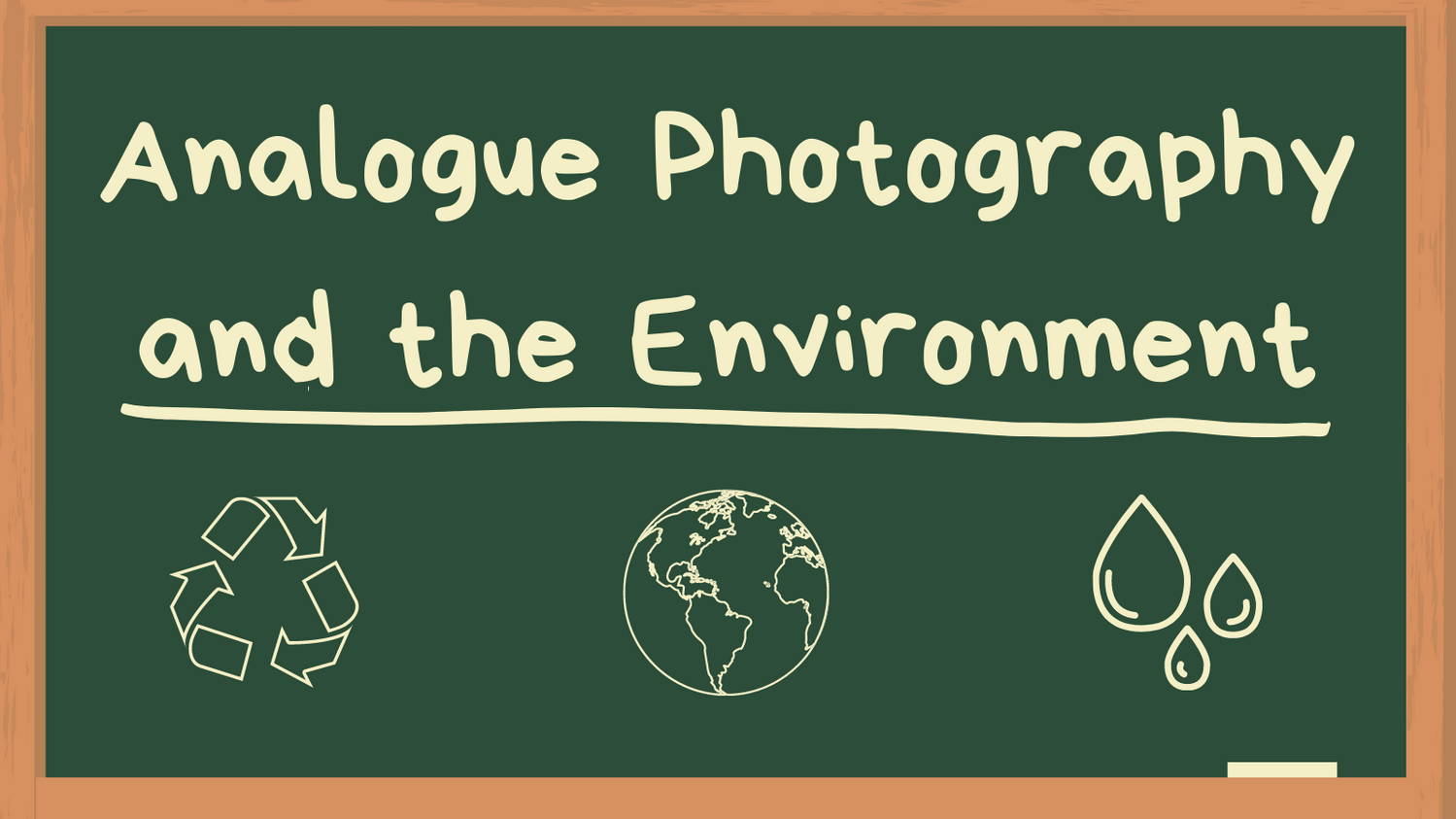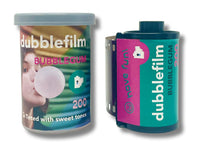Black Friday 2025 has landed at Analogue Wonderland, bringing some of our biggest film photography deals of the year - from discounted film and cameras to money-saving WonderLab processing offers, exclusive bundles, and festive specials available for a limited time only. Grab a great deal while stocks last!
Recent posts
Shop the article

Is Eco-friendly Film Photography Possible?
By Emma Lloyd
Looking after the environment is one of the most pressing issues we are facing today. Living eco-consciously is becoming increasingly important, from the way we run our household, travel, to the food we eat and how we carry out our photographic pursuits. Everyone is questioning how they can live in a more environmentally friendly way and it’s only right the film community does the same. So, is film photography environmentally friendly? And what are the changes we can make in our photography practices to be kinder to our planet?
There are many exciting developments happening to make film photography more eco friendly, this blog will examine the issues we face as a community and the solutions to help tackle them.
Is Film Photography Environmentally Friendly?
Nowadays, no matter what it is that we are doing, the environmental impact is always on our minds. This can be challenging, and somewhat exhausting as there is often no ‘perfect’ way of living a completely eco-friendly life, which can weigh heavily on our conscience. But environmentalism isn’t about perfection, it’s about making an effort.
“We don't need a handful of people doing zero waste perfectly. We need millions of people doing it imperfectly."
-Anne Marie Bonneau, the Zero-Waste Chef
So what are the areas of film photography that need addressing, in order to make the practice more sustainable? Here are the top environmental issues (in no particular order):
- Safe disposal of silver waste
- Packaging waste
- Film is not biodegradable
- Disposable cameras
- Water usage
- Gelatin
- Carbon footprint
- Photographic Chemistry's disposal and hazardous nature
Definitely a few issues to contend with here. But the good news is that we are part of a brilliant film community, all of whom share these concerns. There are lots of projects underway and a definite sense of urgency to make film photography more sustainable.
Analogue photography is on the rise again, so it is important we encourage these changes to make way for a sustainable future of film. Whilst it is unrealistic for it to make a complete comeback that could overtake digital photography, it’s definitely here to stay. Nearly a third of all film users are younger than thirty-five and 60% taking up the hobby have only done so in the last five years, myself included . It is arguably this surge in young film enthusiasts that is behind the desire to propel film into a more sustainable future.
Researching for this blog has been fascinating, enjoyable and filled me with hope for the future of film. Please see a list of resources to check out at the end of the blog.
Making Film Photography more Sustainable
1. The Safe Disposal of Silver from Photographic Chemistry
Black and white film contains a layer of silver halide crystals. These crystals are light sensitive, and when they are exposed to light a a magical chemical reaction darkens the film to produce an image. When the exposed negatives are developed, the silver halide crystals are converted to metallic silver, which blocks light and produces the black part of the film negative. During the developing process, silver is released in the fixer and can also be found in the wash water as a result of being carried from the different processing tanks.
The silver waste leftover after processing film is toxic to the environment, but labs will have an environmental policy to dispose of the silver leftovers properly.
Here is an example from AG Photolab:
2. Eco-friendly Film Photography Packaging
The photographic industry is unavoidably full of packaging. A lot of this packaging is a necessity as we need suitable packaging to transport our film so that it is not exposed to light on its journey! There is also the issue of darkroom practice, test paper and those dozens of prints we produce to create the perfect final piece.
Although we will always need this type of packaging, there are creative things we can do as consumers and changes we are starting to see from film brands, to combat this waste issue.
At Analogue Wonderland we do our bit by using completely recycled and recyclable packaging. We also encourage others to re-use our branded boxes - to send film to labs, to store films in the fridge, or even to make a Pinhole Camera (!)
Other film manufacturers such as Street Candy are leading the way by using cardboard canisters, made out of recycled cardboard to package their films. In his last chat with Paul on Youtube, Vincent Moschetti, the man behind Street Candy, even encouraged us to use the cardboard canisters to plant herbs as the cardboard is completely biodegradable.
Santa Rae is another brand doing their bit, re-using old film packaging to package their own films and not using plastic canisters.
As a consumer, there are alternative ways to buy film that would reduce the amount of packaging used - for example bulk rolls.
This is ideal if you have a favourite film that you regularly shoot with. You can avoid buying lots of individually packaged rolls of film by purchasing metres-worth of film at once, and simply using a bulk loader instead. It can be much more cost effective too.
There are other creative ways to reuse our film waste. For example, turning a canister from your favourite film into a keyring. Here are my house keys, fashionably accessorised with some Dubblefilm Bubblegum, courtesy of Take It Easy Lab.
I spoke to Take it Easy Lab (an amazing indie developing lab based in Leeds) about how many film canisters they get through, which they jokingly quoted as "a disgusting amount" and their plans for them. The lab gets through around 200 canisters a day through the developing machine and since September they reckon they have done 14K colour rolls! That's a lot of canisters stacking up, but the lab has big plans for them. Some of them are turned into keyrings, and the rest they are saving for a huge film canister mural they plan on making soon. Here are some of the canisters waiting to be re-purposed (around 10,000 in this picture!)
There are lots of people getting very creative with their old film canisters, like the Analogue Emporium who create wonderful picture frames old 35mm film canisters.
Re-purposed film canisters (c) Analogue Emporium
I've even seen film canisters up-cycled into wedding invitations. How cute, that's going straight on my Pinterest board!
Film canister wedding invitations (c) petapixel.com
There are also many different ways you could reuse the plastic pots your film comes in, before they are finally recycled. Kosmo Foto has a brilliant blog with 16 ways to reuse your old film canisters including a battery holder, a waterproof matchbox and a slip on flash diffuser. Definitely worth a read!
The main things to remember is to reduce, reuse and recycle. One person’s rubbish can be another person’s treasure! We have even had customers send us in their old 120 spools so they can be re-used by other film photographers in medium format cameras that have lost their take-up spools.
3. Biodegradable Film
Well… it’s not supposed to be! Film is an archival material that you will hold onto forever! Photographers have catalogues of negatives to look through, cherish and keep forever. They are memories to look through, and not meant to be thrown away.
Unless you're using some unique films such as Washi V and Washi W films. They use paper backing rather than the traditional plastic format.
4. Eco-friendly Film Cameras
The film community has developed some bad habits that still haven’t quite died out. Disposable, one-use cameras are no friend of the planet and produce a lot of plastic waste. They are a cheap and fun option for parties and so forth, but we recommend investing slightly more in a camera that you can use again and again.
We sell several re-loadable cameras that are still cheap and cheerful and don’t cost the planet so much! See them here.
5. Water Usage in Film Photography
Film uses a lot of water, specifically in the development stages when you’re required to do a final wash of your film or prints. It is often advised to wash your film or prints in running water, but this can consume a lot of water quickly. Alternative methods such as the ‘soak and dump’ encourage you to soak your prints for a while, then change the water, rather than have a constantly flowing tap.
When home developing I always use Ilford's method with the Patterson development tank: fill the tank with water at the same temperature as the processing solution and invert it 5 times. Drain the water away and refill then invert the tank 10 times. Finally, drain and refill the tank again then invert it twenty times before draining.
6. Vegan Photographic Film?
All photographic film is coated in a gelatin layer, usually a beef gelatin. This coating acts as a binding agent to help coat the film in the light sensitive emulsion. An alternative vegan coating method is yet to be found due to cost and the loss of stability of images. The gelatin is derived almost exclusively from cows from factory farming and intensive meat production. It is well known that the meat industry is one of the largest contributors to CO2 emissions, rearing cows for meat produces the highest amount of CO2 compared to other foods per kg and it is the leading cause of deforestation. 869 cows were required in 2019 to make consumer film stocks.
869 cows needed for consumer film stocks in 2019 (c) Edd Carr Sustainable Darkroom
With film growing in popularity again, these harms will inevitably increase. However, there are some amazing people in the field doing research into alternative methods and sourcing the facts behind gelatin and film, with the goal of finding a gelatin replacement (vegan film). Thanks to Ed Carr, who runs the Northern Sustainable Darkroom in association with the overall Sustainable Darkroom for all his amazing research into the topic and his informative graphics. Ed has written a whole paper titled ‘The Ecology of Grain’ which I encourage you all to check out for more details on these issues.
Gelatin's stick footprint (c) Edd Carr Sustainable Darkroom
7. Offsetting the Carbon Footprint of the Film Photography Industry
Carbon footprint is something we all want to offset and reduce. There are some concerns in the community of the carbon footprint involved in buying film, as a lot of it is imported from Europe or America as well as cameras being manufactured abroad.
My answer to this is that the film community is actually very resourceful! When it comes to buying cameras we share, get them second hand, find them in charity shops and use them again and again and again. Film and cameras are also relatively light weight and small, resulting in a much smaller carbon footprint than other products.
To reduce the carbon emissions surrounding your film purchases, support your local camera shops and businesses. Or buy from brands based in the UK, such as Ilford and Kentmere. Also look out for projects in the community that are doing their bit to help make film photography more sustainable, such as the Northern Sustainable Darkroom.
There are also charities that take donations to help you offset your own carbon footprint, such as the Woodland Trust.
8. Is Photographic Chemistry Harmful?
It is no secret that a lot of the chemistry used in film photography, whether that is developing film or making prints, is toxic. Just look at the warning labels on your chemistry containers to give you an idea.
All film chemistry comes packaged with bold symbols indicating their potential hazardous nature to the user, and environment. However, not everyone will know what these symbols mean and may end up disregarding them.This is not helped by the fact that chemical manufacturers keep the information vague, with statements like 'Domestic users should investigate the arrangements applicable to their local area.' which arguably puts all the responsibility back on the individual.
See below for a breakdown of some of the warning symbols that you may recognise from your own photographic chemistry.
A guide to chemical hazard symbols (c) compoundchem.com
Using chemicals - similarly to when you clean your bathroom - in the most part cannot be avoided. However there are things we can do to use them responsibly. Most labs who are using large volumes of photographic chemistry will have waste disposal methods set up, where the chemicals are collected, diluted and disposed of responsibly, so check that your lab does too! Some labs also use biodegradable chemistry which is less damaging to the environment.
When using smaller quantities of chemistry at home, it is advised to collect used chemicals in a container and take them to your local recycling centre to be disposed of properly. Here are some recommendations from our twitter fam.
- Taking fixer to their city's household hazardous waste site
- Collecting all used chemistry in empty distilled water jugs and taking them to the household hazardous waste drop at the dump once they have collected a few gallons.
- Using caffenol developer, partly because it's eco friendly. Then using 3 tankfuls of water as a stop, and Eco-fixer, which is neutral pH
- Called local hazardous waste disposal and was provided with 2 large jugs. One used for stop bath, fixer and hypo-clear, the other for developers.
Alternatively you could try some homemade chemistry recipes or using plant based ingredients. Marina of If We Film on instagram recently even tried developing with basil. Here are some of the amazing results she achieved!
(c) Marina of If We Film
It is so inspiring to see momentum for environmentally friendly film practices building throughout the community, and the knowledge really growing in this area. In our next blog post, we will be talking to Holly Gilman, another amazing photographer leading the way in sustainable film practices, about black and white film developing! Hopefully this blog has sparked ideas of what you can do to make your film practice more eco friendly, let's keep this conversation going!
Resources:
Emuslive blog on Northern Sustainable Darkroom
Madison Beach brilliant video 'Is Film Photography Bad for the Environment?'
Northern Sustainable Darkroom Linktree of resources
The Sustainable Darkroom // Talk by Bryony Good, Ed Carr and Rachael Allain
The Sustainable Darkroom Instagram
Ready to dive in?
Keep Reading
View all
Film Photography Christmas Gift Guide 2025: Analogue Wonderland
Capture the magic of Christmas with film - no filters needed. Our 2025 Film Photography Christmas Gift Guide 2025 is packed with thoughtful presents for every type of shooter, from curious beginners to seasoned photographers. Discover film stocks, cameras, and creative accessories that will make this festive season truly memorable.

Wedding Photography: Should You Shoot on Film, Digital or Both?
Torn between choosing film or digital photography for your wedding? Wedding photographer Ben Gilholm explores the pros and cons of each format, debunks the myths around film, and shares why your photographer's style is what matters the most when capturing your special day.
Subscribe to our newsletter 💌
Sign up for our newsletter to stay up to date on film photography news, sales and events:
Free Tracked Shipping
On all UK orders over £50
Passion For Film
An unbeatable range and an on-site lab
Our Customers Trust Us
Thousands of independent 5* reviews
All Deliveries are Carbon Neutral
Independently audited and verified by Planet
- Opens in a new window.








1 Comment -
Natalie •
Impressive tone and detail from basil developer. I need more info or resources for legitimately eco-safe color processing in the US.